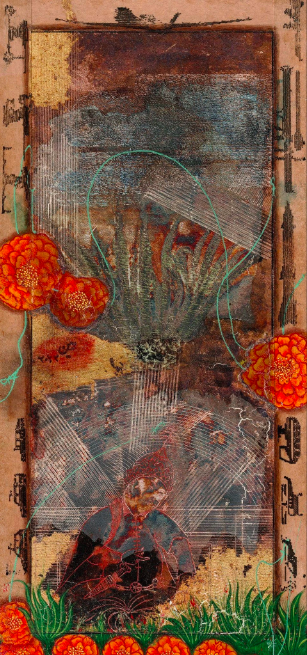(A+ Works of Art) No One Sees What You See 11, 2022
Amin Taasha
Amin Taasha’s paintings draw from the cultural memories of his childhood in Bamiyan, Afghanistan, and the tectonic journey of his life and career that led him to Yogyakarta, where he now lives and works. Taasha’s family was forced to relocate to Kabul in 2000 due to problems with the Taliban. In Kabul, he was exposed to the craft of carpet-making and the teachings of the artist Khadim Ali, both of which had a profound influence on his incorporation of abstraction and miniature paintings in his works. Taasha’s career as an artist took a sudden and unexpected turn when, in 2012, he was invited to participate in DOCUMENTA-13’s international project at the National Gallery of Afghanistan. Taasha submitted two artworks to the exhibition in Kabul: paintings that covered pages of Persian and Arabic text from a textbook, Jame Al-Muqaddmat, a collective work by scholars comprising books on grammar, syntax, logic and ethics in Persian and Arabic. The authorities misunderstood Taasha’s interventions as insulting religious writings and Afghani pride, inciting a fraught event in which the artist was intimidated at gunpoint before being blacklisted from exhibiting his works. The ban spurred the artist’s move to Yogyakarta. When Taasha moved to Indonesia, he brought with him his family’s copy of a book of poetry by the fourteenth-century Persian Poet, Hafiz. The book carries a special significance for the artist, being not only the first book that his illiterate father had bought them as children, but also as a reminder of a belief in his village that: if you can understand Hafiz, you can understand anything in writing. In his family, it felt like this book had its own spirit; they would open the book during times of uncertainty, finding fortunes by opening a random page and discovering its teachings with each section of poetry. Hafiz lived in a very challenging time of turmoil, hypocrisy and uncertainty, and in his biography, Taasha sees an echoing of the instabilities of our current era. Hafiz took his literary tools and crafted a response to this chaos, giving sense through satire, examination, and illumination through a time of great darkness. Poetry has thus formed a significant part of Taasha’s culture and family life. It inspires and comforts him in darker times. The words spin themselves like a web, stretching through words and connections to explain a breadth of questions from the artist. Symbolism therefore plays an important role in his paintings. Some are direct references to their real-world counterparts, like the weapons that evoke discarded ammunition, rockets, and bombs that they would defuse and rework as children. Others, such as horses and crows, stand in as metaphors for refugees and opportunists, or as examples of mythologies in the image of demons that struggle to self-identify but are dehumanised by political beliefs and ideological conflicts. Taasha believes in the unique strength of art to open doors to different ways of thinking, allowing space for the combination of non-related narratives into cohesive (and if somewhat abstract) ideas. In his paintings, he finds a sense of a hidden energy, of understandings waiting to be discovered.
